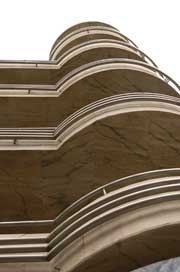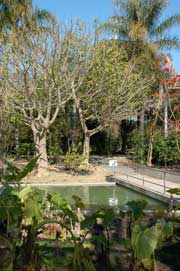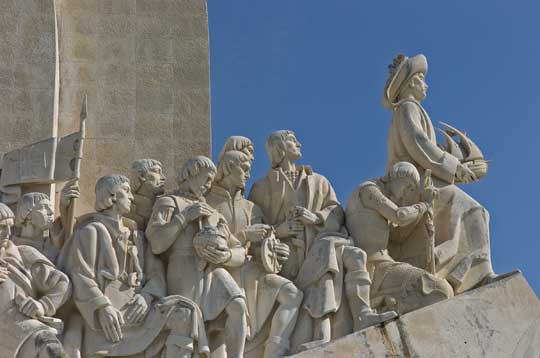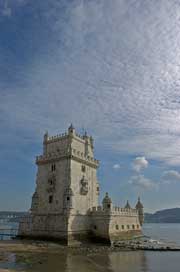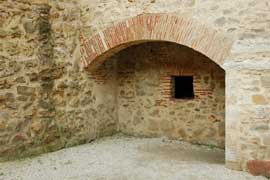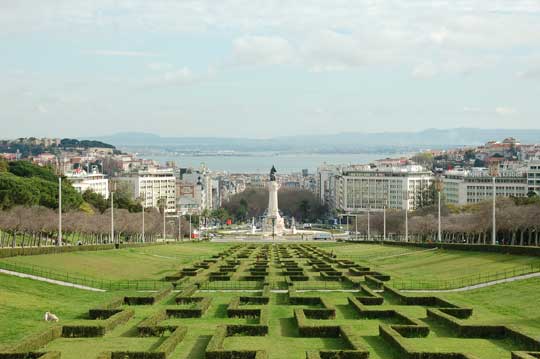Lisbon
|
||
In February 2008, to celebrate our 3rd wedding anniversary, we spent a few days in Lisbon. After the first afternoon (which we basically spent in the hotel eating lunch and spoiling ourselves in the spa facilities), we were very lucky with the weather as it was dry most of the time which just proved the weather forecasters wrong! |
||
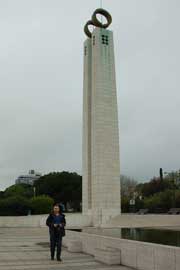 |
Our hotel (Real Palacio) was near Edward VII park so we wandered through there on our way to the main part of the city. The plan was to do the "Day 1" self guided tour from our book but there was so much to see on the way down that we didn't even start it. |
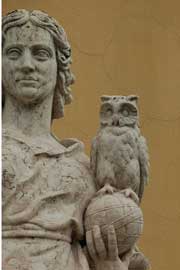 |
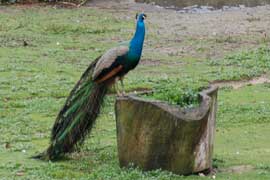 |
Parque Eduardo VII owes its name to the visit of King Edward VII of England in 1903. The Lisbon book fair is held here each May / June and it was a very peaceful park to stroll around and a lovely way to head towards the city centre. There were a few birds around - blackbirds, robin and the inevitable pigeons - and the pond area had a few ducks and a peacock. There were also a few hens pecking about. |
|
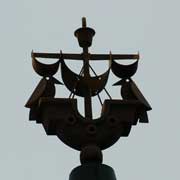 |
One thing we wondered about was why some of the ships on top of the lampposts were black and some gold - we never did find out! |
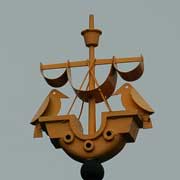 |
At the river end of the gardens, there was a pavillion from days gone by. Whilst it looked like it had seen better days, the tile mosaics were still very special and guarded by some fearsome looking gargoyles. |
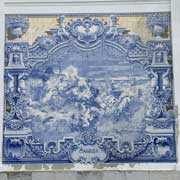 |
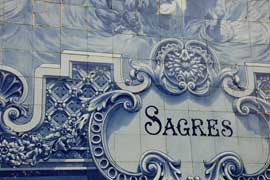 |
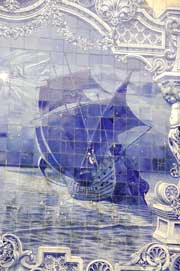 |
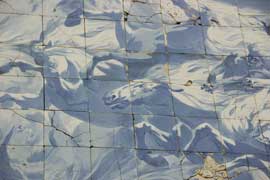 |
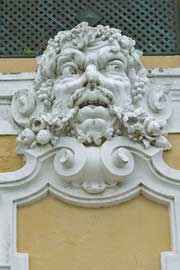 |
There were lots of mosaics on buildings too - some more ornate than others. Some were new and some seemed to be preserving the old mosaics. All added colour and interest as we walked around.
|
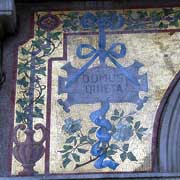 |
|
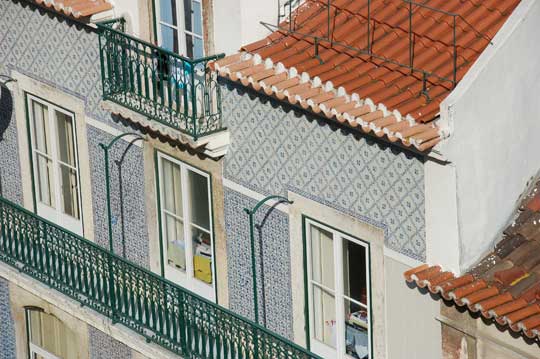 |
||
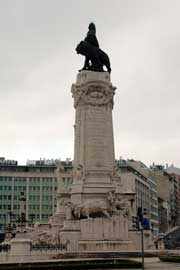
|
Back to our walk - next stop was to take photos of the Marques de Pombal monument. This was in the middle of a very busy roundabout but such minor details have never got in Jonathon's way when he wants a close up so off he went! The Marques is credited with bringing the Enlightenment to Portugal. |
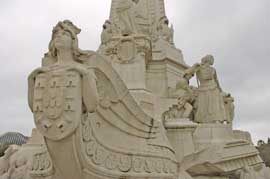 |
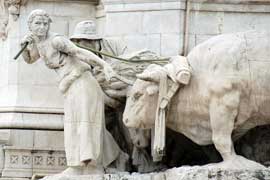 |
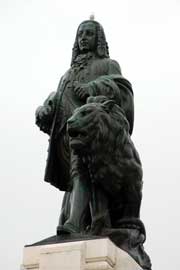 |
Continuing down towards the river we strolled along the Avenida da Liberdade. This seemed to be the main avenue through central Lisbon and while the traffic was pretty busy it was nowhere near as bad as some other European capitals / cities we've visited. The avenue had very wide footpaths, which gave a good sense of space, preventing the traffic crowding pedestrians. There were even some flowers and street art to admire as we wandered along. |
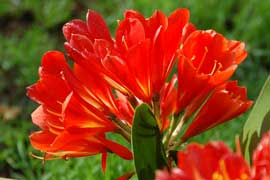 |
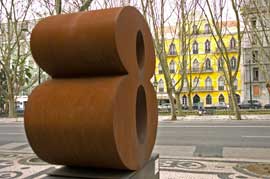 |
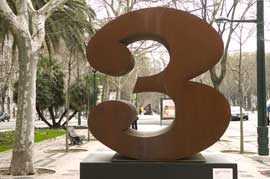 |
The numbers ran the whole length of the road. They were part of an exhibition by Robert Indiana called Love Numbers. They were huge!
|
||
At the end of the road we reached Praca dos Restauradores
- one of several squares we visited. The obelisk is 30m high and celebrates the restoration of 1640 when Potugal regained independence after Spanish occupation. |
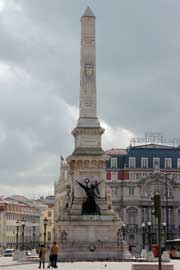 |
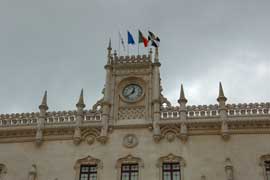 |
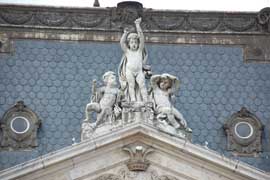 |
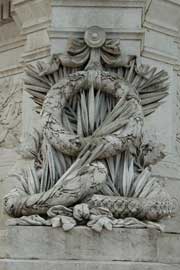 |
There's all sorts of architecture around Lisbon .... |
|
|
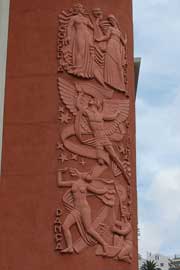 |
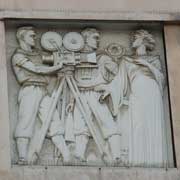 |
.... and a lot of it seems to have an Art Deco influence, not least this old theatre below. It seems that it has been converted into apartments and very nicely done too. The old theatre was Jonathon's favourite building of the first day - I think the frieze top right helped in this choice! |
||
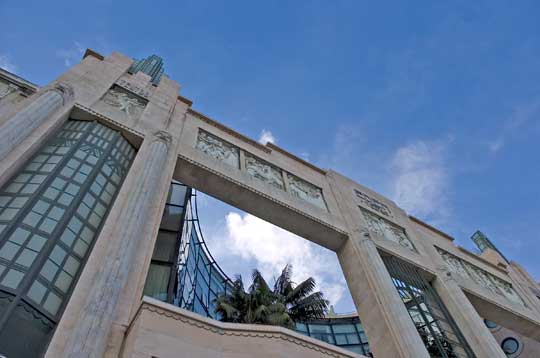 |
||
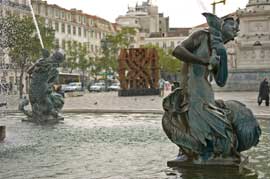 |
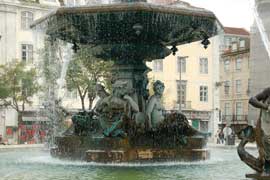 |
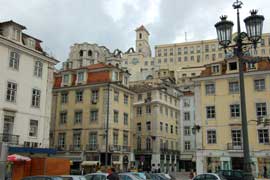 |
Rossio Square (or Praca Dom Pedro) was our next stopping point. It is very large and a big pull for tourists being one of the busiest squares in Lisbon. Rossio means "people's place". The statue in the middle is of D. Pedro IV and the fountains at either end are French. The paving represents sea waves (and you could imagine getting sea sick if you looked at it too long). If you look in the background of the photo below you'll see the Elevador - we went up this. Unbeknown to Jonathon you then had to climb up two circular staircases to get to the viewing platform - he didn't enjoy the climb up or down but managed to get there. |
||
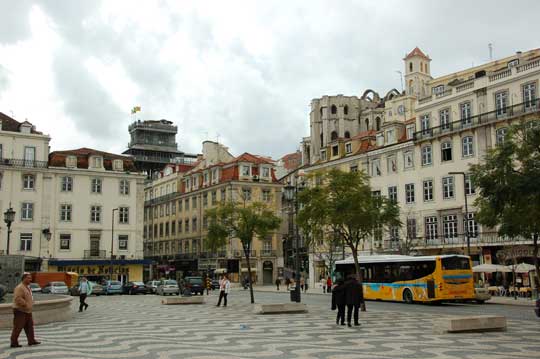 |
||
The best view of the whole of the square was from the top of the platform! While we were in the area we had lunch at Nicola's restaurant (very nice it was too) |
||
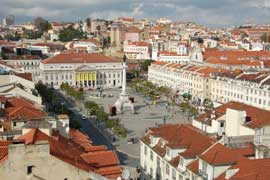 |
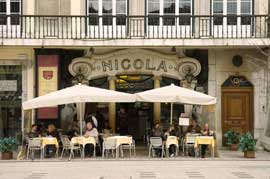 |
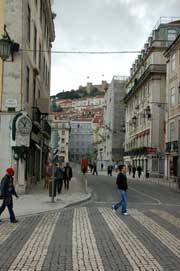 |
You may have noticed the floors in some of the photos so far. A lot of them are mosaic patterns, some with quite unbalancing optical illusions! You've probably guessed that the one on the right is in Rossio Square. |
||
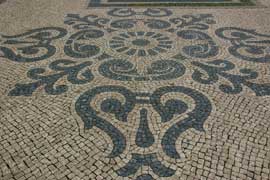 |
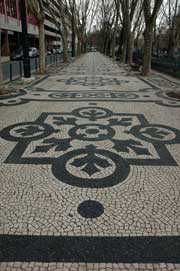 |
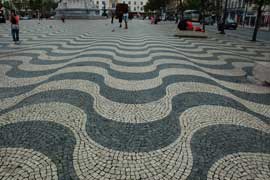 |
Another feature that struck us was the colour. A lot of Mediterranean countries seem to have more colour in their buildings than we do and it's always nice to see. It was funny to see washing hanging out on the balconies but it was a dry and breezy day so I guess it's the best place to get it dry. |
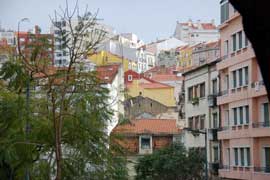 |
 |
Before we went up the Elevador, we managed to get to the river and the Praca do Comercio. This is where the day's walk was to begin so you can see why we didn't get the walk done. We were a bit surprised to see an elephant as part of the base of the statue but he seemed quite sweet so had his photo taken. This square is also known as Black Horse Square although the horse was never black so not sure why. Lisbon was rebuilt after the Great Earthquake of 1755 and this square was the jewel in the crown. Close to the pier, it is where visiting heads of state were welcomed. The statue is of King D. Jose 1. |
||
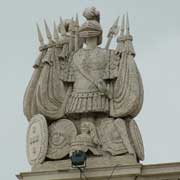 |
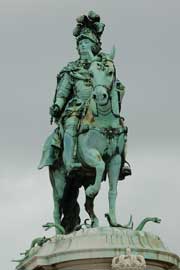 |
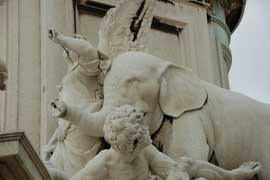 |
The arch below is at the city side of Comercio Square and known as Augusta St. Triumphal Arch. It is of neoclassical design and marks the entry to the Baixa area. The Latin inscription at the top reads "to the greater virtues" and depicts Glory crowing Value and Genius. Below these are four Portuguese heroes - Viriato, Vasco da Gama, the Marques of Pombal and Nuno Alvares Pereira. |
||
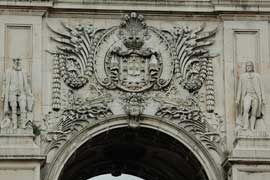 |
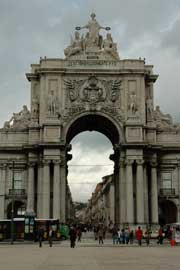 |
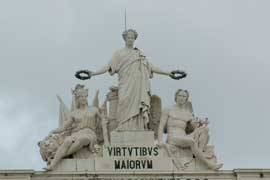 |
Our last treat of the day was the trip up in the Elevador aka St. Justa lift. The Lisbon hilliness justifies the lifts and there are one or two lifts / funiculars around the place. We walked back down as my calves could testify the following day. Largo do Carmo was at the top - an old monastery, now an Archeological Museum which was shut so we couldn't explore the ruins. |
||
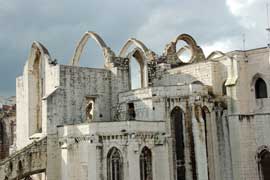 |
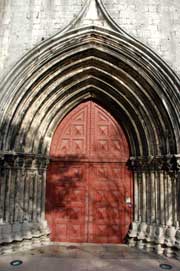 |
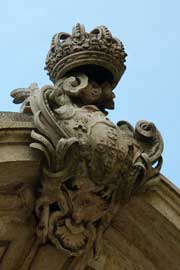 |
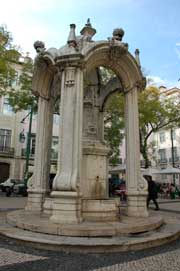 |
Finally, a few views from the top of the viewing tower. I'm sure it was worth the climb, even for Jonathon with his fear of heights! |
|
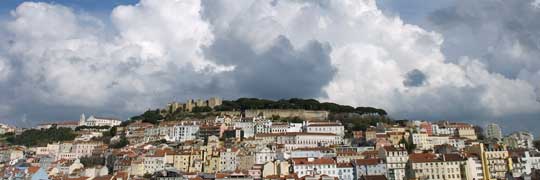 |
||
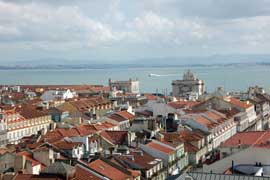 |
The photo on the right shows the castle. This was on our itinerary for Day 1 - our aim was to get there on Day 2 instead! We were also going to try to get to the cathedral on Day 2 but had a complete change of plan - see below! |
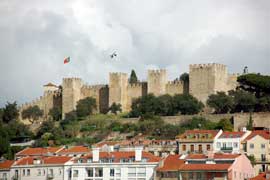 |
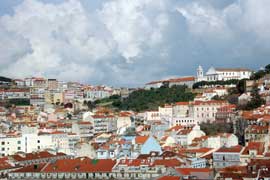 |
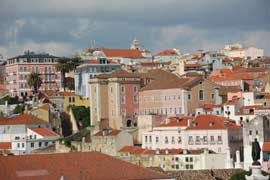 |
Notwithstanding that we didn't see half of what we planned to on our first full day here, we had a lovely time strolling around and enjoying the relaxed atmosphere! |
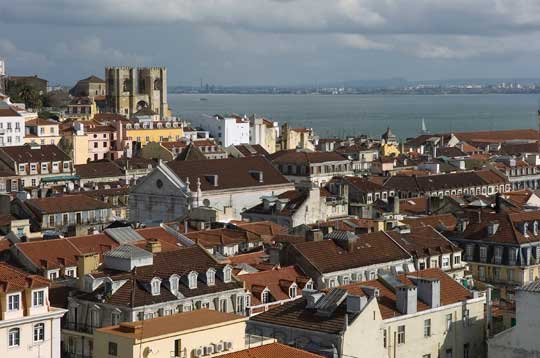 |
||
Day 2 arrived and when we opened the curtains to see if the forecast drizzle had arrived, we were very happily surprised by blue sky. As a result, we decided to head off down to Parque das Naceos. This is on the east side of Lisbon and was completely regenerated for the 1998 Exposition from being a waste land. If the Olympics does half as good a job in East London the extra Council Tax premium will have been worth it. As it was such a beautiful day, we enjoyed the sunshine but we could probably have spent most of the day in the Oceanarium which is one of the largest in the world. Perhaps next time. |
||
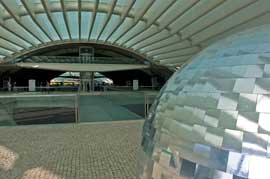 |
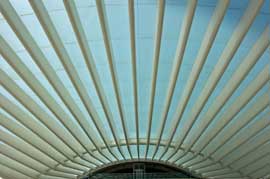 |
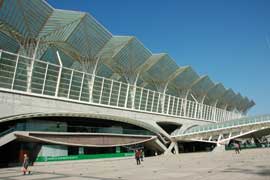 |
We went there by Metro and admired some of the art on the station walls. Oriente Station (our destination) is famous for its architecture and you can see why. It is quite spectacular and really sets the scene for the fabulous architecture in the area. |
||
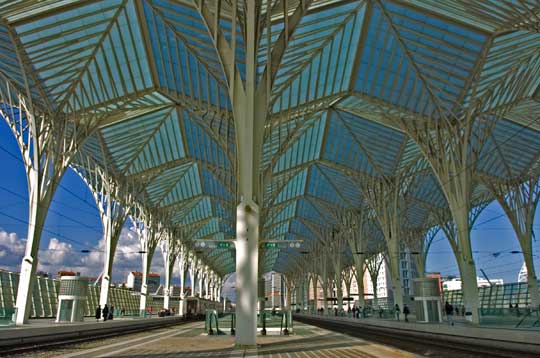 |
||
Along with various amazing buildings, there were also really lovely gardens and a wide variety of styles. |
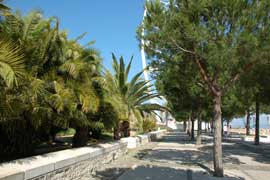 |
The first few photos are of the Garcia d'Orta Gardens which spread alongside the river for quite a while. Its name comes from a 16th century doctor who studied and classified a lot of Asian plants during his 30 years in India. |
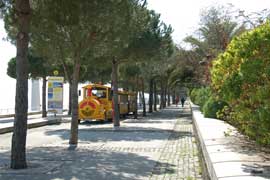 |
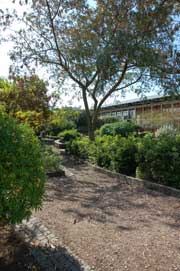 |
|
 |
There was another series of gardens called the Water Gardens including a Mediterranean Grove, Ulysses Pond, Waterfall Building and the Wave Gardens. Some were in the middle of being refurbished while we were there but we had a wander along the "waves" and admired the giraffe! |
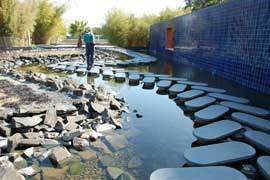 |
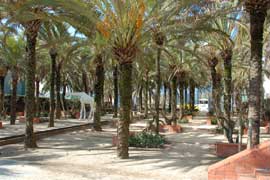 |
 |
The giraffe was part of a sculpture / art installation called "Placing Mirrors" by Fernando Fragateiro. Our favourite garden was the Garden of Sounds. Lots of outdoor musical instruments to play. Jonathon tried to make a wonderful noise on the jumping thing but some of the pads were a little out of tune! |
 |
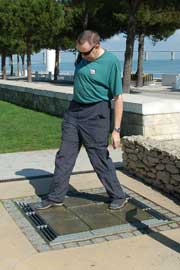 |
The Wave Garden was right next to the cable car that takes you from one end of this area to the other so off we went. We had really good views of the area from the cable car and you could think the two towers are identical but, believe me, Jonathon analysed them (while we were waiting for the train home) and there are several differences! |
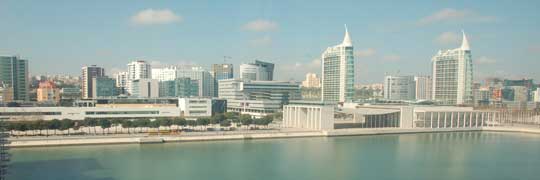 |
||
At the other end were the Vasco da Gama Tower and the Vasco da Gama bridge. The tower is 140m high and there is a panoramic view from the top (we didn't go up). The top is based on a topsail basket and the side bit on a nautical sail. The bridge, of which we could only fit a tiny bit in the photo, is 17 km long! |
||
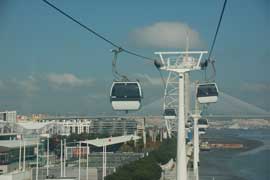 |
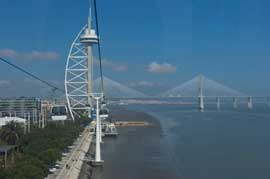 |
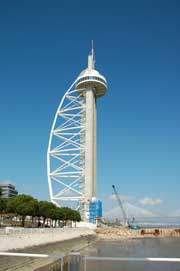 |
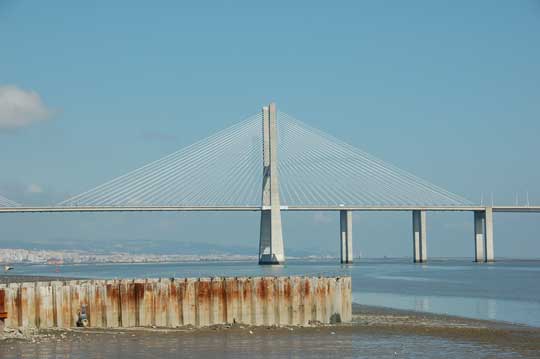 |
||
Wandering around brought us to the Portugal Pavillion with its curved roof. it was designed by Siza Vieira, a Portuguese architect and is now used by the Lisbon Town Hall for cultural events. |
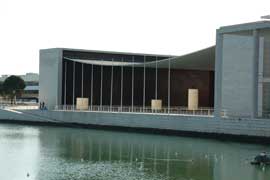 |
There were several other intersting buildings in the area, the next photo is the entrance to a shopping centre. |
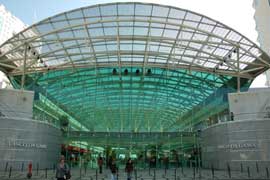 |
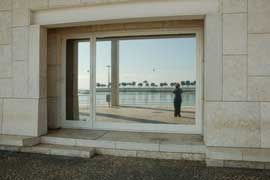 |
There was also a good deal of street art. My favourite was the Sun Man by Jorge Vieira and we both thought the water art was amusing. |
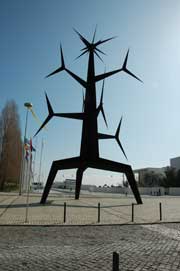 |
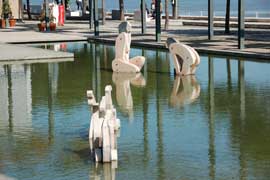 |
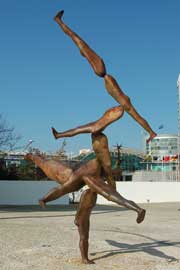 |
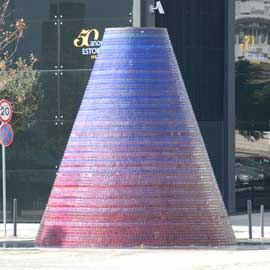 |
With so much greenery and water around, it was hardly surprising that there was quite a lot of wildlife, especially birds and fish. There were also a few frogs enjoying the sunshine in the Wave Garden. |
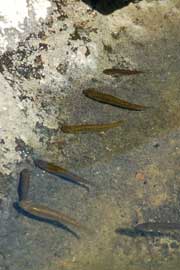 |
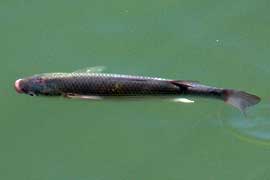 |
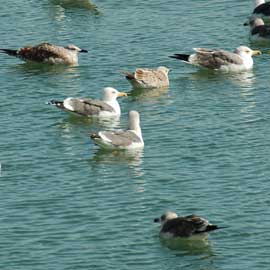 |
 |
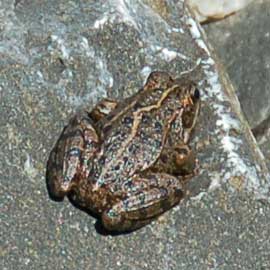 |
A final goodbye to the colour, the holiday / seaside atmosphere and the wonderful architecture and we headed back into the city centre |
 |
Thankfully, our hotel had plenty of spaces to relax in. We enjoyed our fresh orange juice in the courtyard seating area which was inside but felt like it was outside. We didn't take photos in the spa as we didn't want to scare anyone with pics of us in cossies! |
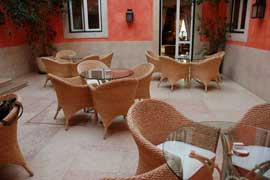 |
Day 3 arrived and it was another lovely blue sky day (so lucky!). Having visited the east of the city yesterday we decided to head west to Belem. Historically a lot of the adventurers started their journeys from Belem so it is an important place for the Portuguese people. |
First of all we had to get there. it probably would have helped if we'd understood that Tram 28 was different from Bus 28 but never mind. We'd been advised to try out Tram 28 anyway so on we jumped. It was a most interesting ride going through some very narrow, steep, twisting streets. I'm sure that we could have touched the walls at the side if we'd put our hands out! Unfortunately it only took us half way to where we wanted to be so then we had to find a bus to take us the rest of the way. No great hardship and it gave us the chance to watch a form of Portuguese relaxation and have out first view of the 25 April Bridge (remarkably like the Golden Gate Bridge in San Francisco we thought). |
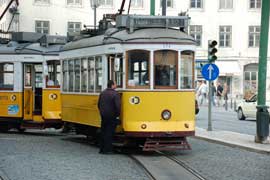 |
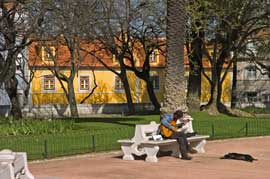 |
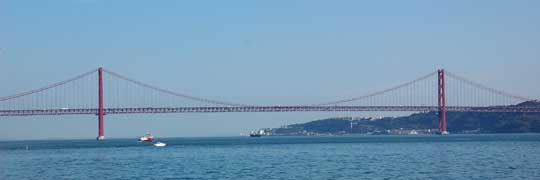 |
||
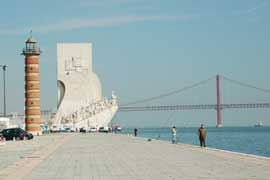 |
Having arrived at Belem, the highlights of the trip were the Discoveries Monument, the Belem Tower and the Monastery. First of all, the Discoveries Monument. |
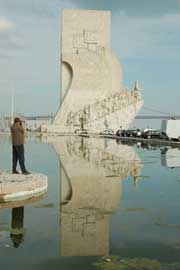 |
|
||
The Padrao dos Descobrimentos (Monument to the Discoveries) was built in the shape of a caravel in 1940 as part of the Portuguese World Exhibition. The prow's statues represent Henry the Navigator leading 32 great figures related to the Discoveries. |
||
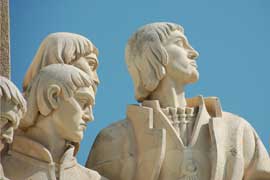 |
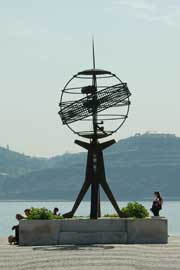 |
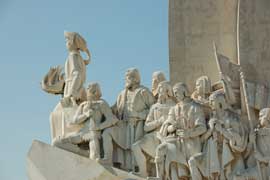 |
We went up in the lift to the top (two flights of stairs too) from where we had a good view of the huge compass mosaic at the base of the monument. |
 |
It also gave us a good view of the Centre of Culture, the fountain in front of the Monastery and the river |
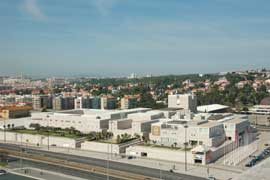 |
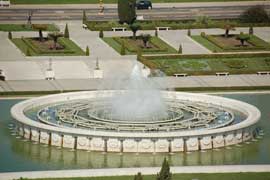 |
 |
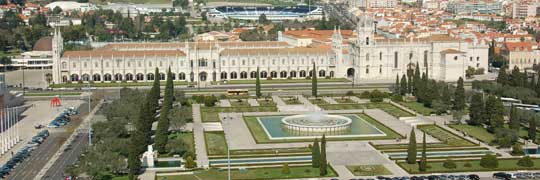 |
||
The pictures above and below here are of the Hieronymite Monastery, an impressive memorial to the Portuguese maritime feats. Its construction began in 1501 and has a 315m long facade. The photo above was taken from the top of the Discoveries monument; the one below is a panoramic view made up of several smaller photos (a la Jonathon) |
||
 |
||
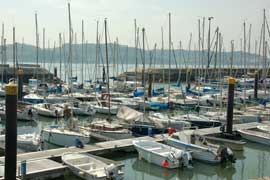 |
There was a thriving harbour at Belem and a very unusual lighthouse - clearly the water is still very important to this part of the city. |
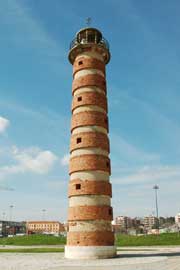 |
We had a delicious lunch at Ja Sei (recommended in our guide book) with both of us trying a local dish (S - salted codfish, J - some sort of wood-oven cooked lamb followed by fidalgo, a very sweet desert). A man, who we think must be the owner, was really friendly and explained the dishes to us in detail, telling us how most of the deserts in the area have their roots in monasterial recipes as they were the only people who had eggs. The egg whites were used to clean the port barrels and the monks didn't want to throw anything away so they made up recipes to use the yolks. The restaurant sits on a float on the river and there was a very welcome breeze blowing through the open door so we had a lovely third anniversary dinner. |
 |
|
After dinner it was time to move down to the Belem Tower. It was built between 1515 and 1521 under the supervision of King Dom Manuel 1's master builder, Diogo de Biotaca to defend the banks of the River Tagus. It now sits out on the river having originally been on dry land. It is a UNESCO World Heritage Site. |
||
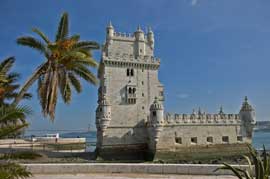 |
|
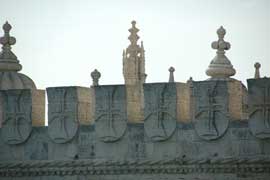 |
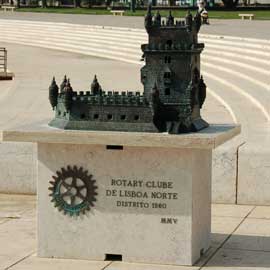 |
This scale model of the Belem Tower was made to help visually impaired people appreciate the tower in more detail. It is wonderfully textured to give the feeling of stone etc. Not far from here was a plane which is a replica of a plane believed to have been the first one to have made a solo flight around the world. |
 |
From there we wandered down to the War Museum because we'd been given a flyer for a Leonardo da Vinci exhibition covering some of his earlier scientific inventions. It was fascinating to see them and try and work out what they were for (the labels were in Portuguese so we couldn't read them too well) |
||
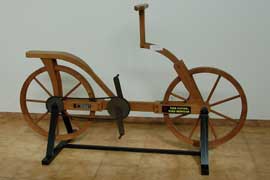 |
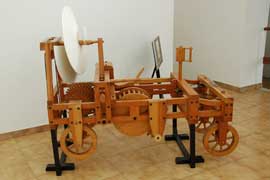 |
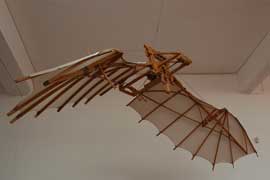 |
At the start of the Day 3 bit I listed the official attractions / tourist sites at Belem. One thing that nobody told us about but was definitely my favourite to see was a new war memorial. It was stunning - quite a simple shape which was deliberate so it couldn't offend anyone (apparently) but so meaningful. It was a "Monument to Overseas Combatants" for all people involved in overseas war. The sculpting of the front face humanises the coldness of the geometric shape and directs attention to the centre where the flame of the nation burns. The surrounding water symbolises the distance and separation of combatants from home and family - very moving. |
||
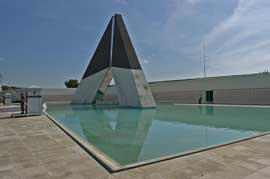 |
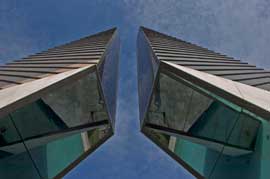 |
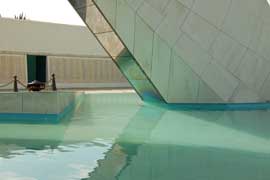 |
All around the sides and back were names of people who'd lost their lives fighting overseas. The years seemed to be the 1960s and 1970s and we believe the war in question was the Angolan War of Independence or the Portugal / Angola war. |
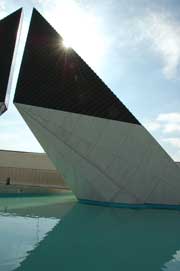 |
By the end of Day 3, and including our trip yesterday, we had been on trains, trams, buses and metros (tubes) - quite experienced public transport travellers! |
Day 4 and we finally managed to visit the castle and cathedral. The castle area is now a garden to relax in although there is still part of the castle there and walls to walk around. |
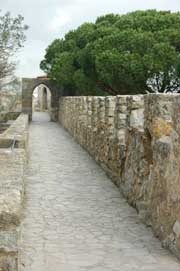 |
It stands on the top of the highest hill in Lisbon and it seemed strange to be looking down on the elevador that we went up on our first day here. |
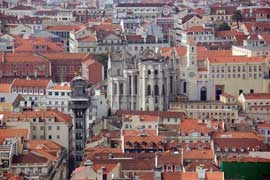 |
With being so high up, the views were spectacular (even thoough it wasn't as sunny as the last two days) |
 |
The castle has a number of towers and it was good to walk around and admire the gardens / views etc. Jonathon even tried to make friends with the local residents. |
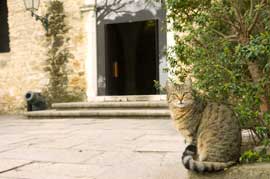 |
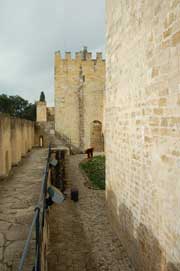 |
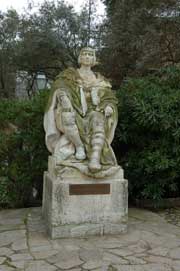 |
 |
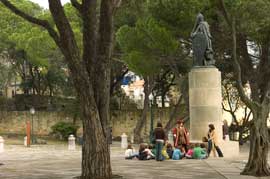 |
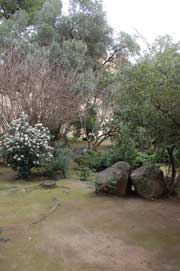 |
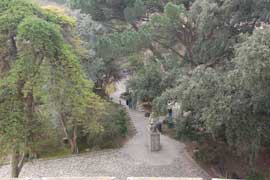 |
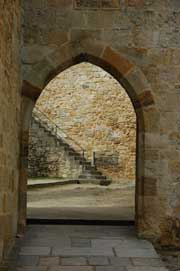 |
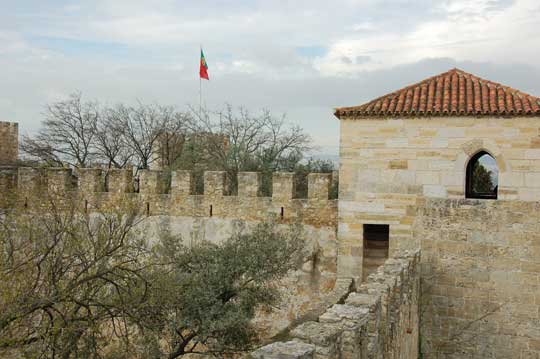 |
||
|
Although we'd taken the tram up (well, a replacement minibus actually) we walked down via the Largo de Sao Miguel. Unfortunately the church we'd hoped to see was closed but the recommended restaurant was open. Its name means "He Loves Me, He Loves Me Not" and very good it was too. |
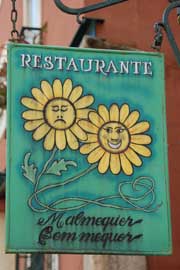 |
From there, we kept going down hill and through lots of little alley ways until we reached the cathedral. |
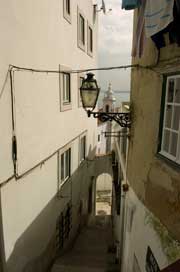 |
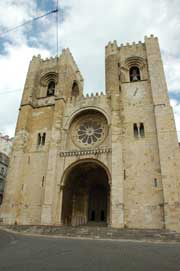 |
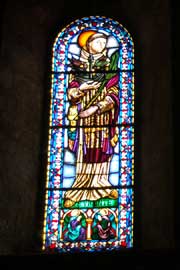 |
It was quite austere but the stained glass windows and the art work were lovely. |
 |
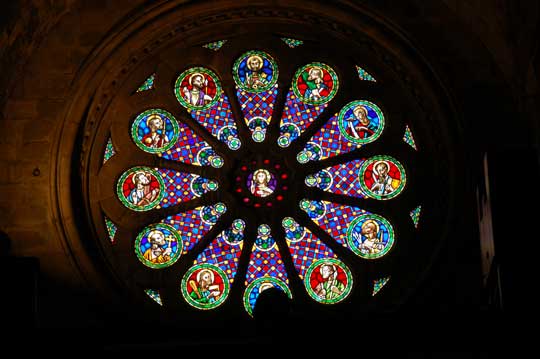 |
||
The cathedral dates back to the 12th century and was built by order of Afonso Henriques, first King of Portugal, after having conquered the town to the Moors in 1147. |
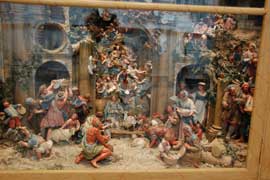 |
The photo on the left was a Nativity Scene - amazingly detailed and very cleverly done. |
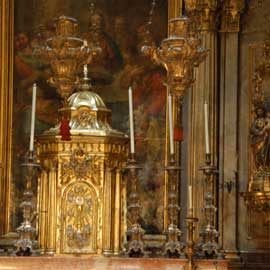 |
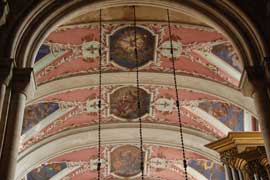 |
The cloisters were open while we were there so we had a look. Some of the excavations go back to Roman times. The cathedral was affected by several earthquakes over the years including the 1755 one that destroyed a lot of Lisbon. It was restored in the last century. |
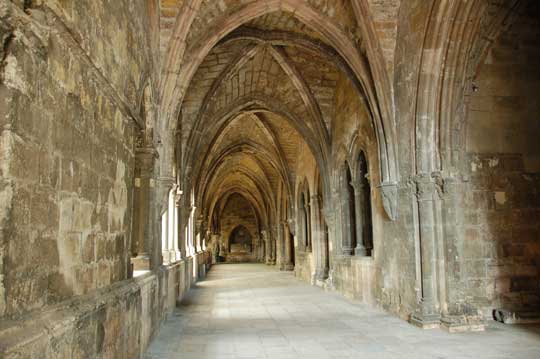 |
||
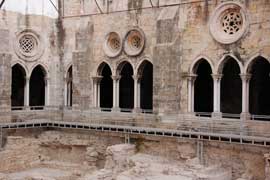 |
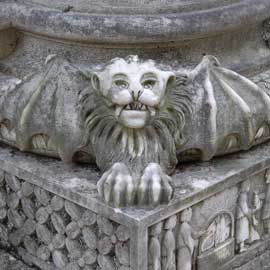 |
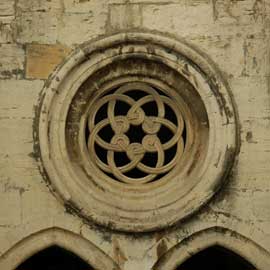 |
Having really enjoyed our time in Lison we had one final visit to Edward VII gardens before heading back to the airport and home. |
||
|
||
